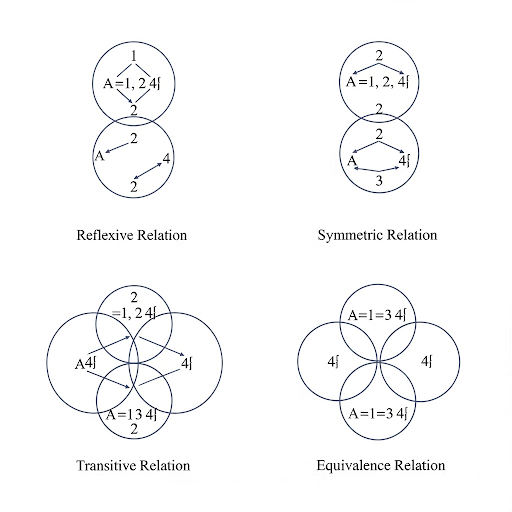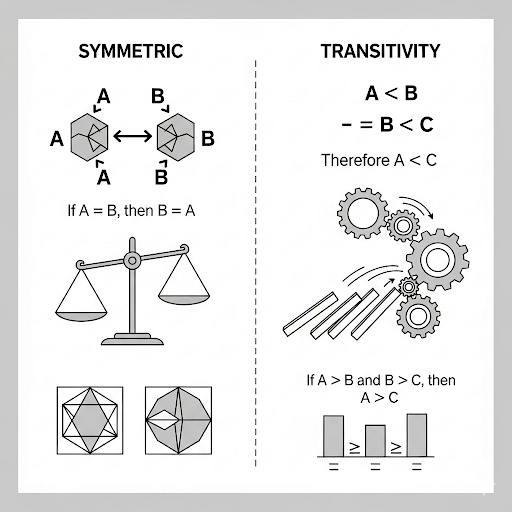1 - Relations
Enroll to start learning
You’ve not yet enrolled in this course. Please enroll for free to listen to audio lessons, classroom podcasts and take practice test.
Interactive Audio Lesson
Listen to a student-teacher conversation explaining the topic in a relatable way.
Introduction to Relations
🔒 Unlock Audio Lesson
Sign up and enroll to listen to this audio lesson

Today, we'll learn about relations, which are connections between elements of two sets. A relation is defined as a subset of the Cartesian product of these sets. Can anyone give me an example of a relation?

If set A is {1, 2} and set B is {a, b}, then a relation could be R = {(1, a), (2, b)}.

Exactly! That’s a perfect example. The relation R consists of ordered pairs where the first element comes from set A and the second from set B. Remember, we denote the Cartesian product of sets A and B as A×B.

What is Cartesian product, again?

Great question! The Cartesian product A×B is the set of all possible ordered pairs (a, b) where a is from A and b is from B. Now, let’s move on to some types of relations.
Types of Relations
🔒 Unlock Audio Lesson
Sign up and enroll to listen to this audio lesson

Relations can be categorized into various types: reflexive, symmetric, transitive, anti-symmetric, and equivalence. Shall we discuss reflexive relations first?

What makes a relation reflexive?

A relation R on a set A is reflexive if every element x in A satisfies (x, x) ∈ R. For example, if A = {1, 2, 3}, the relation R = {(1, 1), (2, 2), (3, 3)} is reflexive.

What about symmetric relations?

Good point! A relation R is symmetric if whenever (a, b) ∈ R, it also holds that (b, a) ∈ R. For instance, if R = {(1, 2), (2, 1)}, it is symmetric.
Properties and Examples of Relations
🔒 Unlock Audio Lesson
Sign up and enroll to listen to this audio lesson

Now let’s explore transitive relations. A relation R is transitive if whenever (a, b) ∈ R and (b, c) ∈ R, then (a, c) must be in R as well. Can anyone provide an example?

If R = {(1, 2), (2, 3), (1, 3)}, that's transitive.

Correct! And lastly, what about anti-symmetric relations? A relation R is anti-symmetric if (a, b) and (b, a) in R implies a = b. Can anyone give me a potential example of that?

What if R = {(1, 2), (2, 1)}? That's not anti-symmetric!

Exactly! Since 1 ≠ 2, it cannot satisfy the anti-symmetric property.
Equivalence Relations and Summary
🔒 Unlock Audio Lesson
Sign up and enroll to listen to this audio lesson

Last but not least, we discuss equivalence relations, which are reflexive, symmetric, and transitive. An example could be R = {(1, 1), (2, 2), (1, 2), (2, 1)}.

So, equivalence relations glue sets together based on those properties?

Exactly! They partition sets into equivalence classes. To summarize, today we covered what relations are, their types, and properties like reflexive, symmetric, transitive, anti-symmetric, and equivalence relations. Any questions?
Introduction & Overview
Read summaries of the section's main ideas at different levels of detail.
Quick Overview
Standard
In this section, students learn that a relation between two sets is a subset of their Cartesian product, leading to an understanding of various types of relations, such as reflexive, symmetric, transitive, anti-symmetric, and equivalence relations. This foundation is essential for future mathematical studies.
Detailed
Detailed Summary
In this section, we explore the concept of relations, a fundamental idea in mathematics. A relation between two sets, denoted as 𝐴 and 𝐵, is defined as a subset of their Cartesian product 𝐴×𝐵, comprising ordered pairs where the first element comes from set 𝐴 and the second from set 𝐵. An example is provided with sets 𝐴 = {1,2,3} and 𝐵 = {𝑎,𝑏,𝑐}, illustrating a relation as 𝑅 = {(1,𝑎), (2,𝑏), (3,𝑐)}.
The section further delves into various types of relations:
- Reflexive Relation: A relation 𝑅 on set 𝐴 is reflexive if for every element 𝑥 in 𝐴, the pair (𝑥,𝑥) belongs to 𝑅.
- Symmetric Relation: A relation is symmetric if for every (𝑎,𝑏) in 𝑅, (𝑏,𝑎) is also in 𝑅.
- Transitive Relation: A relation is transitive if whenever (𝑎,𝑏) and (𝑏,𝑐) are in 𝑅, then (𝑎,𝑐) must also be in 𝑅.
- Anti-symmetric Relation: A relation is anti-symmetric if for (𝑎,𝑏) and (𝑏,𝑎) in 𝑅, it necessitates that 𝑎 = 𝑏.
- Equivalence Relation: A relation that is reflexive, symmetric, and transitive.


Understanding these types is crucial for grasping how interactions between elements of sets can be structured, setting the groundwork for concepts like functions, which are special types of relations.
True or False: If (a, b) and (b, a) exist and a ≠ b, the relation is antisymmetric.
Youtube Videos



Audio Book
Dive deep into the subject with an immersive audiobook experience.
Definition of a Relation
Chapter 1 of 1
🔒 Unlock Audio Chapter
Sign up and enroll to access the full audio experience
Chapter Content
A relation between two sets 𝐴 and 𝐵 is a subset of the cartesian product 𝐴×𝐵. This means that a relation is a set of ordered pairs, where the first element is from set 𝐴 and the second element is from set 𝐵.
Example:
Let 𝐴 = {1,2,3} and 𝐵 = {𝑎,𝑏,𝑐}. A relation from 𝐴 to 𝐵 is a subset of 𝐴×𝐵, for example:
𝑅 = {(1,𝑎),(2,𝑏),(3,𝑐)}.
Detailed Explanation
A relation is a way of connecting two sets of items. When we say there's a relation between set A and set B, we're expressing a specific connection that can be defined using ordered pairs. For example, if A has numbers and B has letters, we might relate these items by pairing them, like (1, a), (2, b), and (3, c). This means that element 1 from set A is connected to element 'a' from set B. The full collection of these pairs constitutes the relation.
Examples & Analogies
Think of a classroom where students (set A) have their assigned desks (set B). If we make pairs of students and their respective desks, like (Student 1, Desk A1), (Student 2, Desk B1), etc., we create a relation that shows which student sits where.
Key Concepts
-
Relation: A relationship between elements of two sets defined as a subset of their Cartesian product.
-
Reflexive Relation: A relation where each element relates to itself.
-
Symmetric Relation: A relation where order of elements does not matter.
-
Transitive Relation: A relation that ensures connectivity through linked pairs.
-
Anti-symmetric Relation: A relation where equality holds if both ordered pairs exist.
-
Equivalence Relation: A relation that links sets by satisfying reflexivity, symmetry, and transitivity.
Examples & Applications
Example of a relation: R = {(1, a), (2, b)} from sets A = {1, 2} and B = {a, b}.
Reflexive relation example: R = {(1, 1), (2, 2)} for set A = {1, 2}.
Symmetric relation example: R = {(1, 2), (2, 1)}.
Transitive relation example: R = {(1, 2), (2, 3), (1, 3)}.
Memory Aids
Interactive tools to help you remember key concepts
Rhymes
In relation, a pair’s the way, each from its set must play.
Stories
Imagine two towns A and B. Each citizen (x from A) marrying a citizen (y from B) creates relations, which can be of different types like friends or relatives.
Memory Tools
Remember F*SAT for relations: F for Reflexive, S for Symmetric, A for Anti-symmetric, T for Transitive.
Acronyms
RSET for Relations
for Relation
for Sets
for Equivalence
for Types.
Flash Cards
Glossary
- Relation
A subset of the Cartesian product between two sets, consisting of ordered pairs.
- Reflexive Relation
A relation where every element related to itself.
- Symmetric Relation
A relation where if (a, b) is in R, then (b, a) must also be in R.
- Transitive Relation
A relation where if (a, b) and (b, c) are in R, then (a, c) is also in R.
- Antisymmetric Relation
A relation where (a, b) and (b, a) in R implies that a = b.
- Equivalence Relation
A relation that is reflexive, symmetric, and transitive.
Reference links
Supplementary resources to enhance your learning experience.
